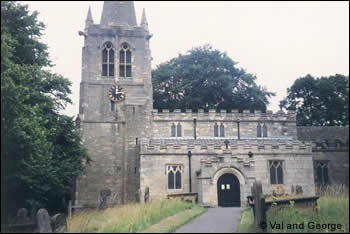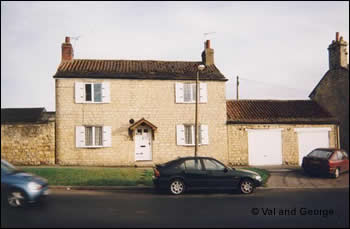I have blacksmiths in my family tree dating back to c1600 when John Dunwell either took over or set up the smithy in the small village of Kirk Deighton in Yorkshire. Opposite the smithy stood the ‘Bay Horse Inn’ and the village green. The hotel stands to this day, however the green has now all but disappeared. Forge Cottage is all that remains of the smithy since the last blacksmith retired c1965 and the forge was turned into garages.

John Dunwell and his wife Anne had eight children in all, although Thomas (1605) and William (1607) died in infancy. Then came Michael (1608-1684), John (1610-1677), Mary (1613-1615) and Robert (1615-1640), followed by William (1618) and Elizabeth (1628-1649). It was John and Anne’s fourth child, John Dunwell, born in 1610, who took over the smithy from his father.
The inn and the smithy would have shared popularity as a meeting place for the men and boys after their day’s work, to talk over the goings on in the village and beyond, and in those days, there was often plenty to talk about. For example, in 1605 there was exciting news indeed, for in November the ‘gunpowder plot’ to blow up the Houses of Parliament had taken place in London, and one of those responsible was a man from York whose family lived close by at Farnley, near Otley – Guy Fawkes.
There was also the Civil War which brought armies marching along the nearby highways. A smithy would have been a busy place during these years, shoeing horses, sharpening weapons or mending bridles and pieces of armour. In 1644, the Battle of Martson Moor took place close by, close enough for the villagers to have heard the sounds of the battle, and they may even have gone along to watch the proceedings.
It would seem that John the blacksmith did well for himself, as when he died in 1647 he was a moderately wealthy man, leaving a precise and business-like will with bequests to his children and grandchildren. His daughter, Elizabeth, was his executor, and it seemed as though his youngest son William had moved away as the will stated “I give and bequeathe to my sonne William Dunwell, if it please God he be alive and come again the sum of three pounds, three shillings and eightpence. Always provided, if he come not againe it to go unto my daughter Elizabeth Dunwell, who if he come must pay him the same”.
Another bequest stated “I give and bequeathe to John Thackray a pair of bellowes, a for? hammer and a hand hammer, and to his sister Elizabeth Thackray foure shillings”. We assume that maybe John Thackray worked in the forge with John.
As well as the monetary bequests to his family, he also left a house to his son Michael, and to his daughter Elizabeth “One close at Igmanthorp called the Calfe Close to the aforesaid house and also house room for one cow and fodder for her”. Wills in those days were so poetic!

Young John (II) had married a girl from the village, Anne Flint, in 1636, and they would have walked up the hill to the village church of All Saints for the ceremony. They too had eight children and the forge no doubt would have been an exciting place for the boys, especially, to grow up in. Francis came first in 1637, followed by Ann in 1639, Elizabeth (1641-41) and John (1644-1680). Then Mary (1646), Robert (1649), Elizabeth (1652) and William (1655), who all sadly died in 1655.
John (II) had taken over the forge from his father and when he died in 1677, he appears to have been less wealthy than his father. His simple will states “I give to my son Francis Dunwell one shilling with all my best wearing apparrell – I give to my daughter Anne Snowden one shilling and one new shirt after my wife’s decease and to ffrank Dunwell’s boy I give one yew. To Anne Snowden’s eldest daughter Elizabeth one yew and to all her other children 5d a piece; but these yews and this five shilling legacy my mind and desire is that they may not be paid as long as my deare wife Anne Dunwell lives, but that they shall be payable at her decease. I desire that my wife will be good to my daughter and her children when she dyes and that the children of my daughter Snowden may have at present my worst cloathes. All my goods and chattels I give to my sd wife and my son John Dunwell making and constituting them joynt executors of this my last will and testament, and that after the decease of my said wife, my sd son John may succeed her in my farme and chattels”.
These wills show that they gave grave thought to the continuing welfare of their families after their demise, and the generous gift of his ‘worst cloathes’ to his daughter Anne would have been a valued legacy for a widow with four children to bring up. The clothes in those days were homespun and made to last, and could be reworked and passed down through the generations. Anne would have understood that Francis, as the eldest son, was entitled to his father’s best clothes.
We assume from the will that John (III) took over the forge from his father, but unfortunately, that is where our connection to the village blacksmith comes to an untimely end. John married Mary outside the village in 1675 when he was 31, but they must have lived in Kirk Deighton as their two children were baptised at All Saints – Mary Anne in 1676 and Peter in 1678. Sadly, John and his wife only enjoyed five years of marriage, for in 1680 they both died, Mary in the July and John in the November. Little Mary Anne died too the following year, aged five, leaving Peter an orphan to be brought up and cared for by family members, possibly by his aunt, the widow Anne Snowden.
The early demise of John meant that he didn’t leave a will and Peter, when he grew up, became a yeoman farmer. So concludes the line of blacksmiths in our family tree. An important village trade that would have been the hub of village life.
Acknowledgement
My mother’s sister Edna Dunwell (1915-1977) did most of the research for this family line, and her legacy to me were the files, folders, paperwork and certificates which I have sorted out and put in some order. Some of the words in this ‘story’ are attributed to her, and it is her I have to thank for my interest in this absorbing hobby.
Val and George
© Val and George 2010